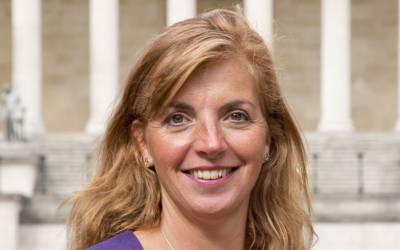
At school I studied Maths, Physics and Chemistry A Level and had an interest in all things medical. Everyone told me I was going to be a doctor.
But all that changed when, in the summer of 1984, aged 17, I was sponsored to attend the London International Youth Science Forum, an annual event which gathers hundreds of students from around the world to learn about science from lectures, debates and visits to various labs and institutions.
The event included a visit to the Royal Marsden Hospital, where I was introduced to Medical Physics for the first time. Straight away I realised that this was a perfect way for me to combine my love of maths and physics with my interest in medicine. I went on to take a degree in Medical Physics and have spent the last three decades working in the field.
Being exposed to Medical Physics while I was still at school had a huge impact on my choice of future career. Today, it remains a little known discipline and too often students are not fully of aware that it even exists. This is one of the reasons that I’m strongly committed to public engagement and outreach activities. But there are other reasons too.
Public engagement and outreach activities have enhanced my communication skills and had a positive impact on how I present my work to scientific audiences. It can be particularly valuable for PhD students; presenting your first talk at a scientific conference can be daunting, but if you have had the opportunity to talk about your work in simple and clear terms in a less intimidating environment can be a great confidence builder.
There are lots of audiences to engage with and learn from. I’ve done stand-up routines in pubs as part of the Science Show Off and Pint of Science events, presented in front of policy makers and funders at the House of Commons and demonstrated Doppler ultrasound to primary school children. Each of these activities has led to unexpected and stimulating questions and interactions which have given me food for thought about the work I do and the impact it can have.
It’s a great way to build teams. Some of the activities I have contributed to have required significant team work and this has been a really valuable experience for our research group. We have developed exhibits for The Royal Society Summer Science Exhibition in both London and Glasgow, and for the On Light event at the Wellcome Collection, each of which have brought together students, postdocs and senior academics for a common purpose. Most recently one of my PhD students led an open day for participants in the BRIGHT project, which is investigating infant brain development in a rural Gambian village. This event, funded by a UCL Culture ‘Train and Engage’ grant, brought together UK and Gambian researchers to devise novel ways of engaging the local (and predominantly illiterate) community with the methods, aims and ambitions of our project.
We can make a difference. Recently, I gave a case study lecture to the second year Biomedical Engineering students. Two of them approached me at the end. One had seen me speak at a Physics in Action event for sixth formers, while the other had been present at an alumni talk I had given at the London International Youth Science Forum. Both cited these events as the moment they had taken the decision to study Biomedical Engineering instead of Medicine. And both were female. Evidence, if any were needed, that public engagement and outreach can, and does, have a direct impact on recruitment.
In 2018, 34 years after I first attended the event as a 17 year old, I became Academic President of the London International Youth Science Forum. This summer, we will be celebrating its 60th Anniversary.
I will always be grateful that this event introduced me to Medical Physics and I look forward to doing my best to inspire the next generation of medical physicists and biomedical engineers.
 Close
Close

